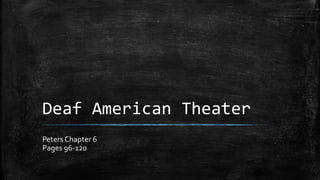
DST 251 Chapter Expert Peters 6
- 1. Deaf American Theater Peters Chapter 6 Pages 96-120
- 2. Deaf American Theater ▪ Deaf Americans perform a wide range of play formats and genres ▪ Mainstream –Dr. Jekyll and Mr. Hyde ▪ Vaudeville –MyThird Eye, Parade ▪ Original/Conventional –Sign Me Alice, A Deaf Family Diary..In many cases, plays such as (Alice) are conventional in form, but original in subject ▪ Hybrid Productions- (a mixture of classical and indigenous theater) Institution Blues ▪ Despite their diversity, original scripts by Deaf American playwrights share general characteristics of indigenous and conventional elements.
- 3. Modern Conventional Theater as High Art ▪ In becoming more “developed, ModernTheater traded in original social and political impulses for aesthetics of the beautiful. (Peters 99). Theatergoers stay in their seats, players stay on stage, and the two groups interact very little (Peters 98). High art aims at the transcendent, highlights social stratification, and leaves a feeling of alienation. ▪ Most plays observe the conventional unities of time, place, and action; in three to five acts, replete with dialogue from start to finish (Peters 98) ▪ Seeks to entertain rather than accentuate cultural identity ▪ Early western drama derived from the Greeks addressed deep concerns of their audience. Modern art contrasts that by avoiding critical issues to offer a moment of escape. Outdoor amphitheater essential part of Greek social life
- 4. A Theater of Two Worlds ▪ 2Worlds -A smaller culture within mainstream culture ▪ The Deaf Communities experience of living in two worlds shaped DeafTheater as Deaf Theater’s goal is to remain relevant/applicable to the viewers daily lives and culture. ▪ The following are examples of two-world condition theater productions: A Deaf Family Diary, Sign Me Alice,Tales from a Clubroom, Deafula, and MyThird Eye. ▪ Many indigenous Deaf productions work diligently to demystify (rid of, clarify) pervasive universal and univocal outlooks, relying on a double-voicedness that highlights the relationship between the reality constructed by aural authority and a Deaf reality whose perspectives, needs, and values-frequently ignored or overlooked.
- 5. A Mundus Inversus ▪ Like many popular rituals of the Middle Ages, these Deaf American plays festively and carnivalesquely turn upside down the usual relations between minority and majority, upending the dominant and focusing on those who are usually marginalized. (Peters 102) ▪ MyThird Eye- clearly depicts carnival ▪ Mainstream society idolizes aural communication, whereas DeafAmericans valorize visual/tactile communication. ▪ “Side Show”- comically draws a distinction between languages two modalities.
- 6. Cultural Encyclopedias ▪ In Deaf AmericanTheater, the feeling of community more highly valued than the narrow assessment of literary and artistic values (Peters 104) ▪ In this respect, Deaf drama resembles the ancient Greek epics whom cultural historian Werner Sollars describes as “cultural encyclopedias” of their time. ▪ Cultural “encyclopedia” pieces such as Institutions Blues, MyThird Eye, and others disperse essential knowledge to the Deaf community by utilizing both Deaf and mainstream culture, vernacular, and artistry. As a result, Deaf Americans better connect to their culture and expand their knowledge on hearing society.
- 7. A Comprehensive Form • Producers of DeafTheater are less concerned with generic distinctions or with creating a “Complete” aesthetic product than with reflecting Deaf culture in all its multifacetedness and building a community of laughter. • Example: Institution Blues- On the surface is a traditional play of three acts and a single theme. But underneath, it is a cultural treasure trove of ASL poetry, ASL art, biography, eulogy, oratory, fairy tales, games, skits, jokes, and satire, framed as a kind of literary night. • 1969- NTID theater program • Vaudeville dates back to the nineteenth century • Silent films were a vaudeville style.They influenced Deaf American vaudeville by supplying plots and other material.
- 8. National Theater of the Deaf (NTD) • Funded by federal government • Geared toward mainstream audiences • Usually presents several short works adapted to sign language in accordance with its philosophy of “See the sign, hear the word.” (Peters 107) • Generally avoids Deaf forms and approaches or material specifically related to the deafness of the actors. (Peters 107) • Aims for the hearing public to be more aware of Deaf people and deaf people more aware of highly artistic and sophisticated theater. (Peters 107) • Many nativist Deaf dramatic productions disregard the conventional separation of the high genres from low, high behavior from low behavior. (Peters 109)
- 9. Collaborative Theater ▪ DeafAmericans relate to the world visually and develop it rhetorically. Rather than presenting oral discourse arranged in a more or less logical progression, the tableau fuses painting, drama (or cinema), and narrative or poetry.This form is independent but often appears within dramatic productions. (Peters 110) ▪ The Collective as the Creator- The director acts more as a facilitator rather than claiming credit for the whole production piece. Actors are heavily involved with sharing ideas, cultural knowledge, and cultural codes. ▪ The Collective as Hero- In mainstream culture, a movie star or celebrity generally attracts most of the attention to “steal the show”. In Deaf theater the ensemble is the attraction. If a feature does single out one person it is as the role of representative ▪ Interaction andViewer participation-BecauseASL is an “oral” vernacular that itself is naturally interactive. Close proximity between actors and attendees is a necessity due to the impractical ways to magnify the face and hands.
- 10. The Carnivalesque Eye ▪ Because the highly verbal quality of modern plays is hard on the eyes, it is not surprising that DeafAmericans go in for the popular and physical over the “high art” of the intellectual, abstract, and serious. ▪ DeafAmericanTheater promotes the real, the sociopolitical, and the community. The dynamic, polyvocal, hybrid, and heterogeneous forms provide lively comical entertainment of “high” mainstream genres.They thereby epitomize the transformation of the spirit of carnival festivities into art.